Instantaneous electric water heater for shower: types, selection tips and review of the best manufacturers
To solve the problem of constant hot water supply in the bathroom, the easiest way is to install an electric instantaneous water heater on the shower. It has significant advantages over a storage device, which we will discuss in detail in this article. Let’s also pay attention to the disadvantages, the main one being the need for a special approach when providing electricity.
Also in this material we will provide recommendations for choosing a suitable water heater, including calculation of sufficient power. We will identify the best manufacturers of electric models, focusing on installation and maintenance. After all, for uninterrupted operation it is necessary not only to correctly calculate the parameters, but also to carry out the installation professionally.
The content of the article:
Features of an electric water heater
The choice of a water heater for a shower between instantaneous and storage type of device is not always clear. Each of them has its pros and cons, and the decision in most cases depends on the capabilities of the power supply system.
Internal structure of the device
In bathrooms, non-pressure water heaters are installed for one dismountable point. They are designed for a single consumer, have 1-2 heating elements and rarely exceed a power of 8 kW. A water pressure, sufficient for the operation of such devices, should be from 0.03 to 0.6 MPa.
The device is turned on when the flow sensor is triggered. The overheating sensor detects the water temperature and turns off the heating elements when it goes beyond the permissible range.
The indicator signals the user about the operation of the heating elements. If it is turned on, but the water does not heat up, this means the heating element is broken - the most common problem with instantaneous water heaters.
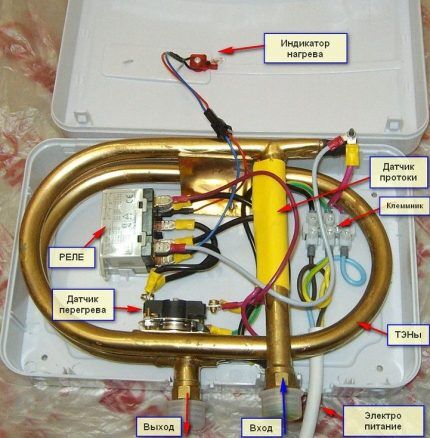
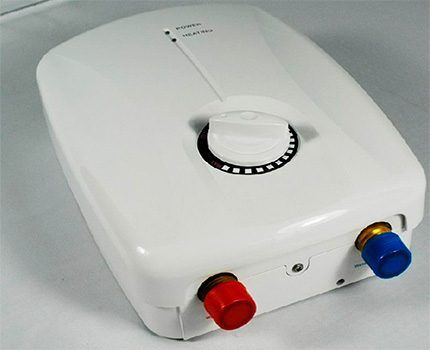
The placement of sensors for water flow and overheating does not allow the heated stream to pass in the opposite direction. Therefore, for safe operation of the device, it is necessary not to confuse the connection points of the cold water input and the heated water output.
Also, for many devices there is a limitation on the maximum temperature of the incoming water. As a rule, it is 30-35 degrees. If this value is exceeded, the overheating sensor will definitely trigger and the water heater will turn off. Therefore, you cannot connect the device to a hot water pipe when, in the consumer’s opinion, there is insufficiently heated water flowing there.
Advantages of flow models
The first advantage of a flow-through device is its significantly smaller size. Placing it in the shower and installing it yourself does not cause problems, while finding a place for a massive storage water heater tank and its installation create significant difficulties.
The second advantage is the significantly lower cost of a domestic instantaneous water heater designed for one point of consumption. Depending on the configuration and brand, the price range of such devices is 1,700 – 8,000 rubles, while the price of the simplest storage water heater with a tank volume of 30 liters starts from 5,000 rubles.
Maintenance and repair of storage devices must be carried out more often, and it is more expensive. In addition, not every consumer can install and connect them independently, which incurs additional costs for paying for the services of a specialist.
When using a storage water heater, it is necessary to take into account the number of people when calculating the tank volume. However, if guests arrive, it may not be enough. The flow-through analogue has no such drawback.
We have more criteria for comparing instantaneous and storage water heaters reviewed here.
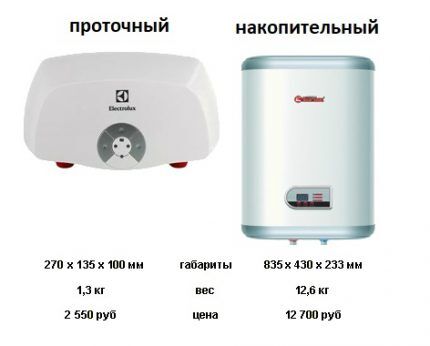
The problem of providing electricity
The only significant obstacle to deciding in favor of an instantaneous water heater is the peak load on the electrical network. It exceeds the performance of a storage device several times.
Purchasing an instantaneous water heater significantly increases the requirements for the electrical cable. The total power of common bathroom appliances, such as a washing machine (when the heating element is operating 1.5 - 3.0 kW), heated towel rail (0.4 - 0.6 kW) and lighting line (0.1 - 0.25 kW ) rarely exceeds 4 kW.
To provide such voltage, a wire with a copper core cross-section of 1.5 or 2.5 mm is sufficient.2, which is often brought to such premises.
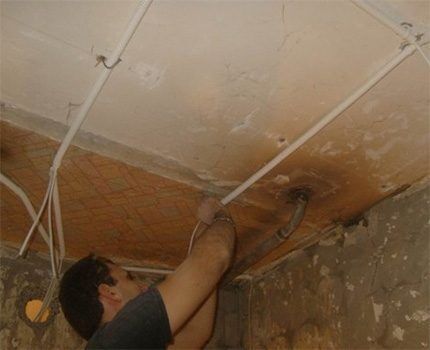
However, the presence of a flow heater increases the maximum power consumption of the circuit section to 6-10 kW and then a cable with a cross-section of 4 or 6 mm will be required2. This means that before installing the device, it is often necessary to replace the wiring, and it is better to separate it into a separate branch to the distribution (internal) electrical panel.
The second problem after wiring may be the load on the electrical outlet. They are marked with permissible voltage and current.
Using these data, you can calculate the maximum possible power of the connected electrical appliance without the risk of damaging the outlet:
P=I*U
Where:
- P – equipment power (Watt);
- I – current strength (Ampere);
- U – mains voltage (Volts).
Household sockets for a network with a standard voltage of 220 Volts have a permissible current of 5, 10 and 16 amperes. Consequently, devices with a maximum consumption of 1100, 2200 and 3520 watts can be connected to them, respectively. If a higher power heater is used, it is necessary to install power outlets.
They have the following standard parameters:
- 25 amperes (connected device power up to 5.5 kW);
- 32 amps (up to 7.0 kW);
- 63 amps (up to 13.8 kW);
- 125 amps (up to 27.5 kW).
If there are difficulties when installing a power outlet, you can connect the power cable to the terminal block.However, this procedure should only be performed by a professional electrician, since unskilled work may cause the connection to overheat and cause a short circuit. This cannot be allowed in a room with high humidity.

If the existing electrical supply of the bathroom allows the alternate use of energy-intensive devices, then you can choose this option. To prevent forgetting from turning them on at the same time, it is enough to use one socket for two devices.
The last problem may be the maximum connected load of an apartment or house when connecting to a common energy infrastructure. For gardening and private houses with old power lines, it can be only 4-6 kW.
Then you can use a instantaneous water heater only if almost all other devices are turned off. But even with the standard 15 kW of permitted power, it is necessary to calculate the peak load.
What to look for when choosing a water heater?
First of all, the choice of instantaneous water heater should be made taking into account the sufficiency of its power, and then pay attention to the brand. When purchasing a device from a common series from a well-known manufacturer, you can be sure that it will be quickly repaired in the event of a breakdown. This is facilitated by the availability of spare parts and experience in troubleshooting typical problems.
Calculation of the optimal power of the device
The relationship between the power of an electric water heater, water flow and the increase in temperature of the water flow is calculated as follows:
P = 0.073 * Q * (T1 – T2)
Where:
- P – device power (kW);
- Q – water consumption (l/m);
- T1 – outlet flow temperature (°C);
- T2 – inlet flow temperature (°C).
Thus, the outlet water temperature can be calculated as follows:
T1 = T2 + 13.7 * P/Q
The temperature of the incoming water from our own well remains virtually unchanged throughout the year. Its value can be measured, it is usually 8-12 degrees. The temperature value with centralized cold water supply is more dependent on the time of year and ranges from 5 degrees in winter to 15 degrees in summer.
The maximum water flow can be measured experimentally. To do this, just note the time in seconds during which you can fill a liter bottle, and then divide the number 60 by the recorded value.

Knowing the power of the device, you can calculate the outlet flow temperature.
You can adjust it as follows:
- when the pressure is reduced using a tap, the water temperature rises;
- when the power of the water heater decreases, it decreases.
For most people, the comfortable range when showering is between 35 and 42 degrees. To be able to flexibly adjust the flow parameters, it is better to use a water heater with several power modes.
This is also important for centralized water supply, since it is possible for a long time reduction in water pressure as a result of repair work on highways. In this case, the device operating at maximum power will produce a flow hotter than required.
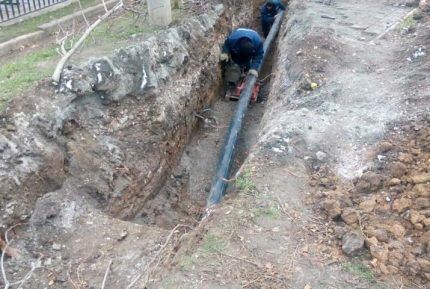
As an example, consider a standard apartment with centralized water supply. The cold water temperature in winter is 5 degrees, in summer – 15 degrees. The maximum jet pressure is slightly more than 4 l/m. The desired pressure for taking a shower is at least 3 l/m. Comfortable temperature range is from 35 to 40 degrees.
Pin winter = 0.073 * 3 * (35 - 5) = 6.6 kW.
Pin summer = 0.073 * 4 * (37 - 15) = 6.4 kW.
Thus, it is necessary to purchase a water heater with a total power of heating elements of about 6.5 kW. If the pressure in the water supply network periodically decreases, then you need a device with functions to turn off one of the heating elements.
Popular series from famous manufacturers
Almost all well-known manufacturers of instantaneous electric water heaters offer a range of devices with identical characteristics.
This is due to the standard pressure in the water supply and approximately the same water flow parameters, which contribute to a comfortable shower.
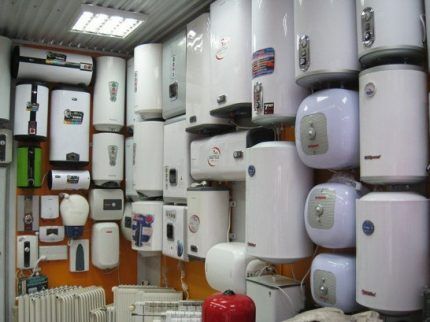
Series Smartfix 2.0. Swedish manufacturer Electrolux is represented by three devices equipped with two heating elements with the following maximum power:
- 3.5 (1.5 + 2.0) kW;
- 5.5 (2.2 + 3.3) kW;
- 6.5 (3.0 + 3.5) kW.
Availability of letter "T" at the end of the device name means it is equipped with a crane, and "S" - shower head. They are connected via a standard 1/2-inch connector, so existing attachments can be used. Assembly is carried out in China and Russia.
Series Stream Italian manufacturer Thermex represented by three devices with maximum power limits of 3.5; 5.0 and 7.0 kW. Water heaters also have two heating elements. Russian assembly, lower price range.
Series Whell Swedish manufacturer of water heating equipment Timberk also presented in three models with a maximum power of 3.5; 5.5 and 6.5 kW. There is a restriction on the minimum permissible inlet water flow temperature (16 degrees), although, according to reviews, the device works well at lower values. Chinese production.
Series H-IWR Korean manufacturer Hyundai presented in three models with maximum power parameters of 3.5; 5.5 and 6.5 kW. Buyers note the smell of plastic, which disappears after a while (Chinese production).
The common series of water heaters presented above have a bottom connection and are intended for use in bathrooms. All devices of the same model range have the same design and construction, differing only in the power of the heating elements.
We have provided a rating of the best models of instantaneous water heaters, based on popularity among customers and positive reviews. next article.
Nuances of connection and operation
For trouble-free operation of an instantaneous water heater, you will need to study the principle of its operation and know the basic technical characteristics of the device. There are also connection and maintenance nuances that will allow you to avoid problems during its operation.
How to properly connect a water heater?
There are water heaters with bottom, top and side water supply. In bathrooms, as a rule, the lower version is used. It is necessary to determine the optimal connection method before purchasing the device, since it is prohibited to install it in a different position.
Connecting to cold water occurs in two ways:
- to the shower connector of the faucet-shower switch;
- directly to the cold branch of the water supply.
The first method leaves the possibility of using a standard water tap to obtain cold water bypassing the water heater.
In a user-designed plumbing system, shut-off valves cannot be used after an instantaneous water heater. Otherwise, this will lead to overheating even if there is a thermal sensor shutdown function. This rule is directly stated in the instructions for many devices.
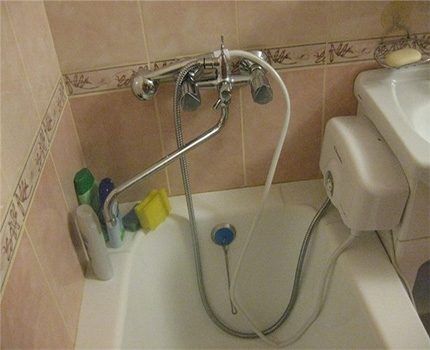
According to electrical safety requirements regulated for hygienic premises GOST R 50571.7.701-2013, sockets for 220 volts in the bathrooms must be installed in the third zone (further in plan than 60 cm from the shower, bathtub or sink faucet) and comply with the degree of protection IPX4 or higher.
At a distance of more than 3 meters from water supply points, you can install ordinary class sockets IPX1.
Despite the fact that the instantaneous water heater is designed for wet rooms and has good tightness, when choosing an installation location, it is necessary to take into account the undesirability of a direct stream of hot water. This causes the case to heat up, which will negatively affect the tightness of the connections and the performance of the control panel. In addition, the ingress of water reduces the strength of fixation of the device to the wall.
Fastening to the wall occurs using standard methods using screws. The weight of the device is from 1 to 3 kg, so there is no need to take any measures for reinforced installation. Some owners do without fixing the device, but this should not be done, as there is a risk of the device falling and depressurizing during its operation, which is dangerous for people in the room.
Do you want to install a instantaneous water heater yourself? We recommend that you familiarize yourself with step by step instructions on installation.
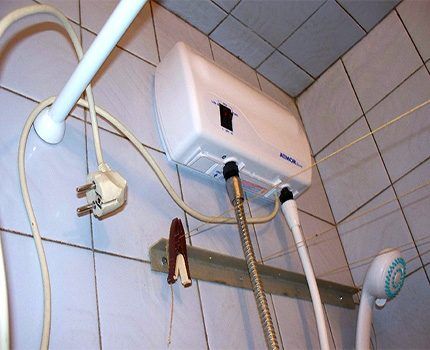
Recommendations for operation and maintenance
In addition to wiping the surface of the water heater with soapy water, periodic maintenance involves changing the filter installed on the cold water supply.
To do this, perform the following actions:
- disconnect the device from the power supply;
- close the water supply tap;
- unscrew the hose;
- remove and wash the mesh filter;
- Reassemble the device in reverse order.
For trouble-free operation, it is important to configure the equipment correctly.
The water temperature must be adjusted in the following order:
- Open the tap and wait for water to flow out of the water heater.
- Turn on the water heater. After 10 seconds the temperature will become constant.
- If the temperature is not suitable for taking a shower, then change it by adjusting the pressure and operating modes of the water heater.
After each action to change the water supply pressure or the power of heating elements, you must wait 10-15 seconds to establish constant temperature values.
We have provided detailed instructions for the operation and maintenance of the water heater In this article.
Conclusions and useful video on the topic
Mounting to the wall, connecting the water supply and starting the Electrolux Smartfix water heater:
An example of improper use of a water heater. The device is not secured, the tap is installed after the hot water comes out:
You can calculate the required power of an instantaneous water heater, mount it and connect it to the water supply yourself. The greatest difficulty is in the safe supply of electricity to the device. Choosing a well-known manufacturer will ensure a quick solution to problems in the event of a device breakdown.
Do you want to ensure year-round availability of warm water in your shower by installing a flow-through water heater model, but your friends convince you that such a solution is ineffective? Ask your questions under this article - real owners of instantaneous water heaters will share with you their experience of use and their own opinion on the advisability of installing it.




It would also be interesting to read about calculating electricity consumption when using flow-through and storage heaters (about the financial costs of the user). I realized for myself that design and installation should be done either in a new building or during a major renovation of the bathtub/kitchen. Because installing a heater on an existing tile and laying a cable 4 mm2 from the panel is quite a troublesome task. And if you throw the cable on top, without hiding it in a box, then it turns out like a collective farm. Although, based on the real photos presented, the idea of aesthetics arises due to the abundance of hoses and wires. With a good renovation in the bathroom, it seems to me that it will hurt the eye.
About a year ago we moved to a private house. Only cold water is supplied. There was no bath or shower at all. I allocated a room for a bathroom where the former storage room was located. While the repair and installation is underway, there is still quite a lot of work to be done, but the question has already arisen: how to heat the water? I'm afraid a large water heater won't suit me, space is very limited. I'm still looking for options.
You are unlikely to find anything smaller than an instantaneous water heater. Unless you use a boiler to heat water in a basin :)
Hello. Most likely, you are confusing a flow-through heater with a storage heater. The flow type has minimal dimensions, but the storage one is quite large. We can advise you to purchase a small-volume boiler (but it may not be enough for bathing), an instantaneous water heater, or install a storage boiler in the kitchen. Distribute hot water to both rooms.
3 l/m - the flow is not for the shower, but for the tap.A shower with such consumption is a dacha “write” to somehow rinse off a little. In practice, a good shower requires at least 12 kW of power.